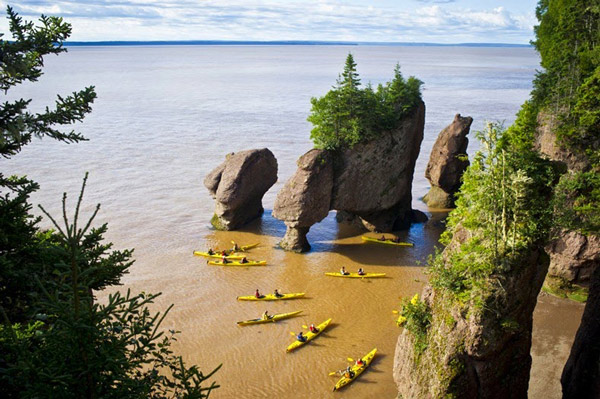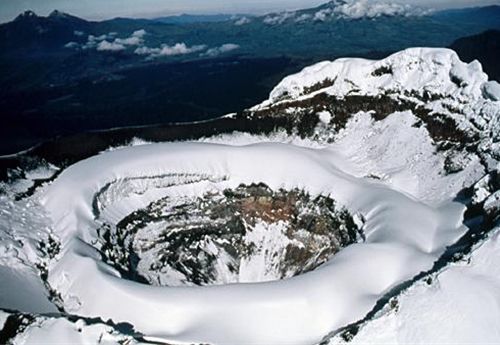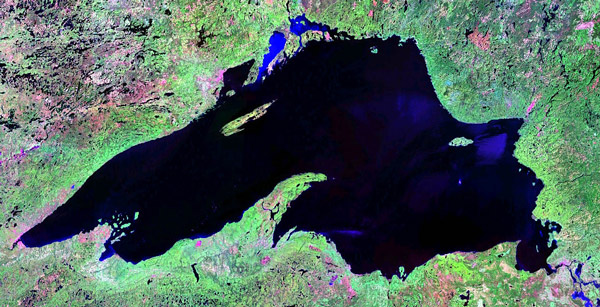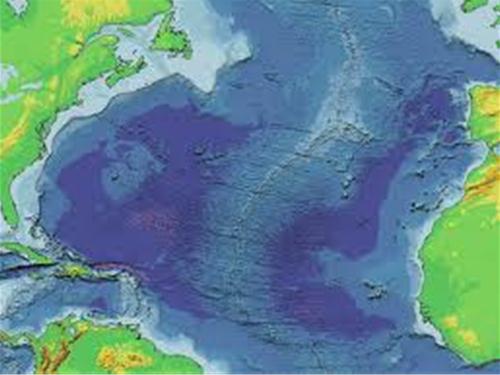101 interesting things about the earth (Last term)
Earth is a special and extraordinary planet in the universe with a wealth of things that people do not know yet. Here are some interesting facts about our planet.
Discover 101 unexpected interesting things about the Earth
81. Where is the highest tide?
At Burntcoat Head in the Bay of Fundy in Nova Scotia (Canada), tides can rise as high as 11.7 m. The Bay of Fundy has a funnel-shaped shape that often creates large tides.

82. The only place where glaciers flow through the equator?
Cotopaxi mountain in Ecuador has the only glacier squeezed through the equator.

83. The largest lake in North America?
Lake Superior , adjacent to Ontario and the US state of Minnesota to the north and with two states of Wisconsin and Michigan to the south, is the largest and deepest lake of the Great Lakes in North America and the third largest in the world with an area of 82,103 km².

84. The most terrible storm ever landed in America?
The level 4 storm hit Galveston, Texas, in 1900 killed more than 6,000 people.
85. The world's longest mountain range?
The Mid-Atlantic Range is located in the sea almost dividing the entire Atlantic Ocean from north to south. Iceland is where this underground mountain range juts out of the sea.

86. How much gold has been mined on earth before?
More than 193,000 tons. If you put them together, you will create a 7-story cube building
87. The two largest gold producers?
South Africa produces 5,300 tons / year. The US ships 3,200 tons / year.
88. Do North American plants last thousands of years?
Creosote shrubs growing in Mojave, Sonoran and Chihuahuan deserts have lived since the birth of Jesus. Some plants can live up to 10,000 years.

89. On average, how much water is consumed globally every day?
About 1.5 billion cubic meters.
90. Saturn is the only planet with a ring around it?
Saturn has the clearest belt. But Jupiter and Neptune stars have faded belts.

91. How often do earthquakes occur?
Most vibrate about 80 km below the earth's surface. The heavier battles have greater damage. But the destructive power of each vibration depends on the soil structure and the design of the building.
92. The coldest, driest and highest continent on earth?
It is the South Pole.

(Photo: knitteldude)
93. Where is the oldest stone in the world found?
Because the ocean floor is frequently transformed when the lithosphere moves on the earth's surface, the oldest rocks found on the seabed are about 300 million years ago. And the stone on the oldest continent has 4.5 billion years old.

Ancient sculpture in Mexico.(Photo: mylittlehomepage)
94. How much fresh water in the world is stored in ice?
About 70%. In order to get this amount of water, it is necessary to rain continuously for 60 years globally and must find a way to freeze all of it.

(Photo: fragmentsfromfloyd)
95. The largest mountain lake in North America?
Lake Tahoe on the 42,500-hectare California-Nevada border, containing 0.1 billion cubic meters of water and 488 meters deep.

96. Are continents always available?
Not the same as we see now. Many scientists believe that the earth used to be a huge, arid continent, the water brought from comets and oceans forming. Then all the land in the world gathered into a supercontinent called Pangea. It began separating 225 million years ago, eventually dividing into continental arrays as we see it today.

(Photo: Pangea.org)
97. How many volcanic ash fell every day?
Take an example. In an intense 9-hour eruption at Mount St. Helens on May 18, 1980, more than 540 million tons of ash poured over an area of 56,980 square kilometers. It was the most terrifying volcanic eruption that ever happened in America.

Mount St. Helens on May 18, 1980, dropped more than 540 million tons of ash covering an area of 56,980 square kilometers
(Photo: vulcan.wr)
98. What is feldspar?
Feldspar, also known as a jelly or a bodhisattva stone, is the name of a group of rock-forming minerals that constitute 60% of the earth's crust.

99. America's end points?
The farthest point to the east is Amatignak Island, Alaska. The farthest point north is Point Barrow, Alaska. The farthest point to the south is the southern tip of the island of Hawaii. The farthest point to the west is Pochnoi Point in Semisopochnoi, Alaska.

(Photo: mun.ca)
100. If you were to arrange Earth, Moon and Mars like Matryoshka dolls, how would you put them?
Mars will fall into the earth, and the moon will fit into Mars. The earth is twice as massive as Mars and Mars is almost twice as much as the moon.

(Photos: nsschapters)

(Photo: pda.physorg)
101. Will the earth always be there?
Astronomers already know that in a few billion years, the sun will be so big that it will "swallow " the earth. If we were still there, it would have been burned and evaporated. If there is an opportunity, we can "push " the earth into a different and more peaceful orbit.

(Photo: star.arm)
- 101 interesting things about the earth (Term 4)
- 10 interesting things about life you may not know
- 101 interesting things about the earth (Term 1)
- 19 interesting things about the Earth
- Video: Interesting things about the Earth
- 101 interesting things about the earth (Term 2)
- 10 interesting things about nature you may not know
- 101 interesting things about the earth (Term 3)
- 9 reveal interesting surprises about your IQ
- Going from one surprise to the other is different from the interesting things about all things
- Super interesting things about math you will definitely fall back
- 12 horrible things about China you may not know
 The 11 most unique public toilets in the world
The 11 most unique public toilets in the world Explore the ghost town in Namibia
Explore the ghost town in Namibia Rare historical moments are 'colored', giving us a clearer view of the past
Rare historical moments are 'colored', giving us a clearer view of the past The world famous ghost ship
The world famous ghost ship